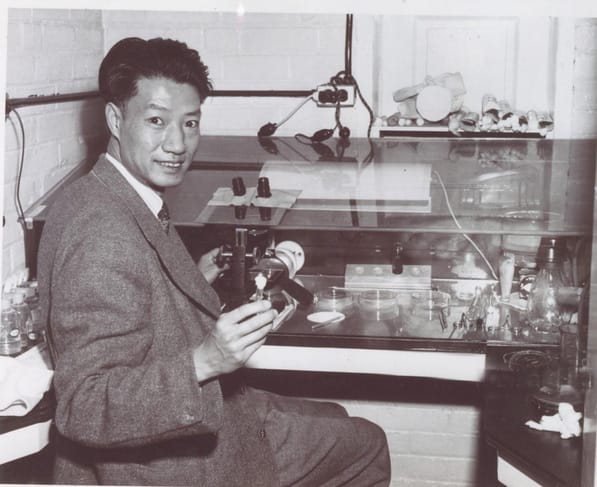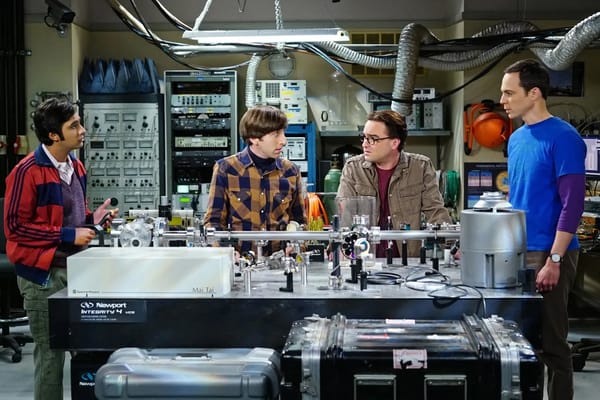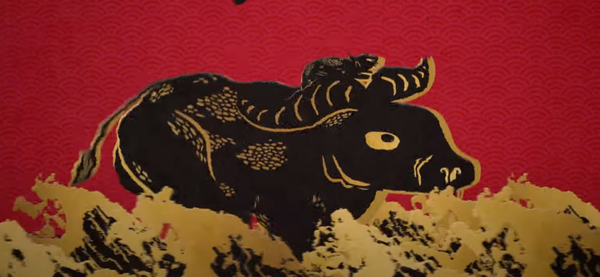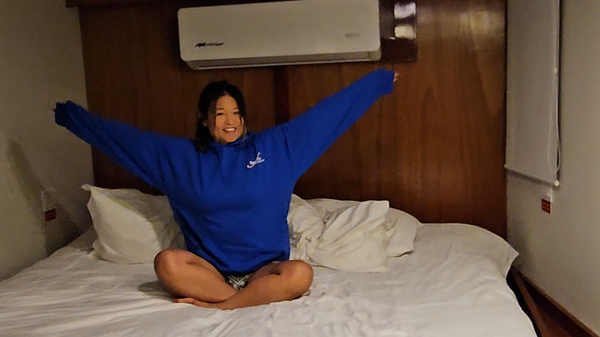For years, I hid my PhD. But no more.

“Have a core belief. Gut check it every day. Pursue it with all your might. Pursue it for a very long time. Surround yourself with people you love. And take them on that ride.” - Jensen Huang at Stanford 2024
Asian American, Native Hawaiian, and Pacific Islander (AANHPI) Heritage Month ends today. In honor of this we are going to talk about the significant contributions our demographic has made to scientific discovery.
First, a look back. Asian inventors and innovators have contributed greatly to human advancement for centuries.
Gunpowder in 1000 CE
Compasses a hundred years later
Algebra
Even our basic number system. (The base-10 decimal system we use today was solidified in India in the 7th century.)
Now, as Asian Americans, we are a fusion of Asian traditions and the American Dream.
But, often, we have been reduced by weaponized stereotypes: quiet, bookish, introverted, and inclined to excellence in STEM. It’s so normalized that you see an Asian American student and assume she’s good at math or that he is studying engineering. We are told by mentors to reject the stereotype, write our application essays on something unrelated to family or tradition, and seek “well-rounded” experiences to break the mold. All while diminishing our STEM achievements.
Because that would be expected.
Because that would make us “less.”
When I started in venture capital, I was told to strategically minimize my science background.
A PhD with an Asian last name told anyone who read my resume or took my business card the only things they thought they needed to know about me.
That I couldn’t understand consumer.
That I wouldn’t be relatable.
That I was just another data nerd.
Maybe surgically removing the “PhD” takes away the implied bias that comes along with it.
But we should view these achievements with pride.
And, with Skeleton Key, I’m putting my PhD back in my bio, highlighting my scientific knowledge alongside my venture expertise in every conversation and every deal.
So, to wrap up this month, I want to take the time to celebrate scientists who are already leading thanks to their curiosity, dedication, and intelligence.
Isabella Abbott, PhD (1919-2010) was a native Hawaiian botanist whose dedication to ethnobiology and the study of seaweed and algae led to the discovery of more than 200 species of both organisms. She was also the first ever Native Hawaiian woman to earn a doctoral degree in any field of science when she earned a PhD in botany from the University of California Berkeley at the age of 31. Later, she became the first woman and person of color to be appointed as faculty in the biological sciences department at Stanford University, where she had already been lecturing for over a decade.
Ajay Bhatt (b. 1957) is an American computer architect who produced several widely used technologies, including USB (Universal Serial Bus). He joined Intel in 1990 as a senior staff architect on the chipset architecture team in Folsom and he holds one hundred and thirty-two U.S. and international patents. Several others are in various stages of filing. As Intel's Chief I/O architect responsible for the platform and I/O interconnects directions, Bhatt also leads definition and development of the next-generation Client Platform architecture.
Subrahmanyan Chandrasekhar, PhD (1910-1995) was an Indian-American theoretical physicist who made significant contributions to the understanding of stellar evolution, black holes, and the structure of stars. He was awarded the 1983 Nobel Prize in physics along with William A. Fowler for "...theoretical studies of the physical processes of importance to the structure and evolution of the stars." His mathematical treatment of stellar evolution yielded many of the current theoretical models of the later evolutionary stages of massive stars and black holes. Many concepts, institutions, and inventions, including the Chandrasekhar limit and the Chandra X-Ray Observatory, are named after him.
Min Chueh Chang, PhD (1908-1991) was a Chinese American reproductive biologist whose research led to the development of both in vitro fertilization and the oral contraceptive pill. His research involving the fertilization of rabbits, golden hamsters, mice, and rat ova helped form the basis of the in vitro fertilization of human ova by Patrick Steptoe and Robert Edwards, which later led to the birth of the first “test-tube baby,” Louise Joy Brown in 1978.
Leon Ong Chua, PhD (b.1936) is an American electrical engineer and computer scientist. He has contributed to nonlinear circuit theory and cellular neural network theory. He is the inventor and namesake of Chua's circuit, one of the first and most widely known circuits to exhibit chaotic behavior, and was the first to conceive the theories behind, and postulate the existence of, the memristor. Alongside Tamas Roska, Chua also introduced the first algorithmically programmable analog cellular neural network (CNN) processor. Thirty-seven years after he predicted its existence, a working solid-state memristor was created by a team led by R. Stanley Williams at Hewlett Packard.
Yuan-Cheng Fung, PhD (1919 – 2019) was a Chinese-American bioengineer whose research into the physics and mechanics of living tissue helped lay the groundwork for the modern fields of bioengineering and biomechanics. After earning his PhD in aeronautics and mathematics, he went on to become an expert in the field of aeroelasticity before shifting his focus to bioengineering. His discoveries included breakthroughs in vehicle safety and artificial skin grafts, and an expanded understanding of pulmonary and small-vessel circulation.
David Ho, MD (b. 1952) is a Taiwanese-American researcher who is celebrated as the inventor of a combination antiretroviral therapy method that dramatically increases survival rates against HIV/AIDS. The Aaron Diamond AIDS Research Center (ADARC) was where Ho did most of his groundbreaking work, including the development of his strategy, utilizing protease inhibitors and reverse transcriptase inhibitors for patients in the virus’s early stages. He continues to work on the development of an HIV vaccine.
Harvey Akio Itano, MD, PhD (1920–2010) was a Japanese-American scientist whose collaboration with Linus Pauling changed the course of sickle cell anemia research and helped to establish the field of molecular medicine. Itano was born in Sacramento in 1920 and was imprisoned with his family at the Tule Lake internment camp in California during WWII. Despite the ordeal, he earned a medical degree from St. Louis University and a PhD in chemistry and physics from CalTech. At CalTech, he used electrophoresis to discover that the hemoglobin from the red blood cells of sickle cell anemia patients differed from healthy hemoglobin, a finding that represented the first demonstration of a disease caused by an abnormality in a single molecule.
Fei-Fei Li, PhD (b. 1976) is a Chinese American computer scientist whose work in artificial intelligence, machine learning, computer vision, and cognitive neuroscience has improved how computers identify objects. In the last twenty years, she has been a leader on the ImageNet project, a database that provides image data for researchers. Li is a Co-Director of the Stanford Institute for Human-Centered Artificial Intelligence, and a Co-Director of the Stanford Vision and Learning Lab.
Peter Tsai, PhD (b. 1952) is a Taiwanese American inventor who improved meltblown filtration manufacturing techniques and patented technology that used positive and negative charges to trap dust and bacteria in a filter before it entered the mouth. The technology is used inside N95 masks. He studied chemical fiber engineering at the Provincial Taipei Institute of Technology, now known as National Taipei University of Technology.
Nianshuang Wang, PhD is a Chinese scientist whose research into coronaviruses became pivotal to the design of mRNA vaccines created during the COVID-19 pandemic. He has a Bachelor’s degree in Life Science from the Ocean University of China and a Ph.D. in structural biology from Tsinghua University. During his academic career, he determined the structural mechanism of MERS-CoV receptor recognition, partnering with another lab in 2014 to isolate the first monoclonal neutralizing antibody against MERS-CoV. Four years later, during a fellowship at McLellan Lab at the University of Texas, he did research into coronavirus spike proteins, which would be used for the design of COVID-19 mRNA vaccines.
We need to continue celebrating excellence from Asian American scientists like these and the 39 Asian Nobel recipients in Physics, Chemistry, or Physiology or Medicine. And there will only be more Asian American scientists who will change the world in their own unique ways. The Institute of Education Sciences reports that 14.4% of STEM bachelor’s degrees/certificates given to U.S. citizens and permanent residents were awarded to AANHPI students.
In VC-land, as we spoke about previously, science-related startups are gaining traction, accounting for an increasing portion of venture capital funding since 2019. In fact, funding for science-related technologies has grown ~2x, from 12% to 28% in 2023. And as we spoke about here, there will only be more to come as AI unlocks the potential for ScienceTech companies.
But right now, let’s consider some other stats.
Asian Americans represent 7% of the U.S. population...
13% of the U.S. professional workforce…
But only 6% of middle management posts…
And only 3% in executive roles.
This is the largest proportional drop of any population.
Likewise, Asian Americans are the least likely to be promoted to senior management and leadership. In fact, a 2016 study found that one of every 12 white men and one of every 28 white women in the professional workforce is an executive, but only one of every 30 Asian American men and one of every 64 Asian American women have reached executive level.
Because of the systemic bias against Asians as “visionary” “leaders.”
But in this era of rising interest in science-related startups, let’s remember that we’ll need leaders who understand science and business. Leaders who can be celebrated for their abilities and visions.
Leaders like Jensen Huang
An Asian American.
An electrical engineer.
The co-founder and CEO of Nvidia.
The 3rd largest company in the world by market cap
A trillion dollar company
Led by an engineer in a leather jacket.
He saw the need and the market before they existed.
And he sold the idea to Don Valentine without them.
So let’s end the month with my favorite excerpt from his speech this spring at Stanford GSB:
Have a core belief.
Gut check it every day.
Pursue it with all your might.
Pursue it for a very long time.
Surround yourself with people you love.
And take them on that ride.




